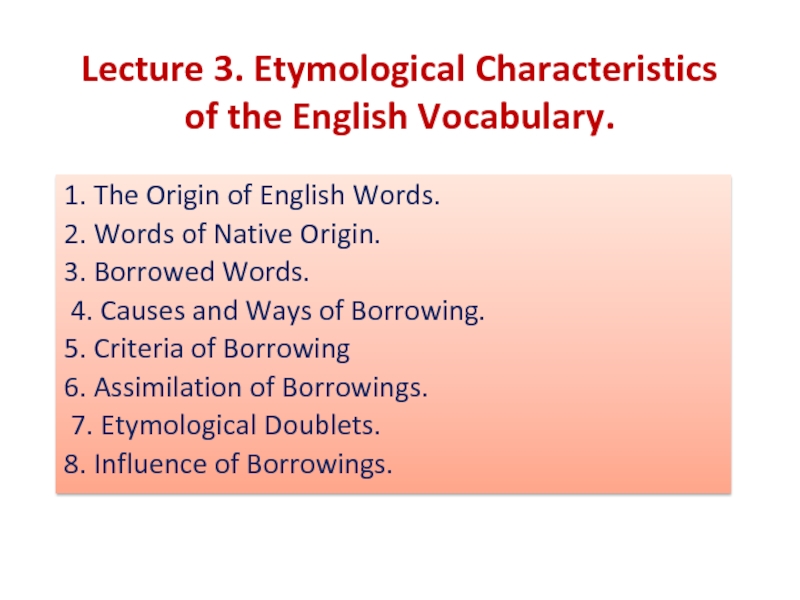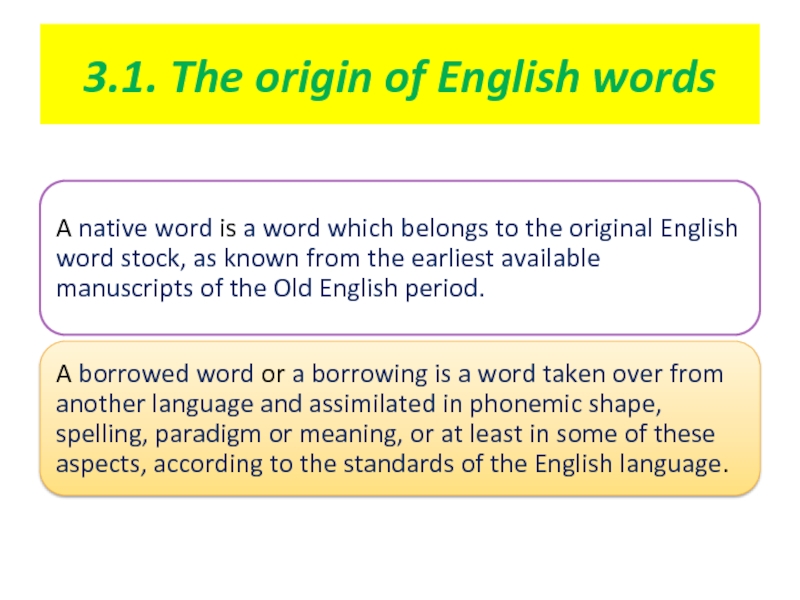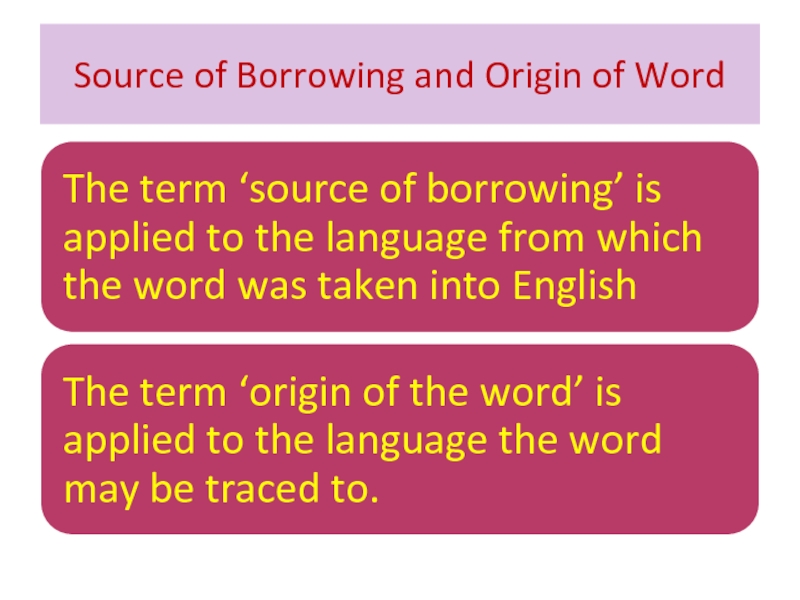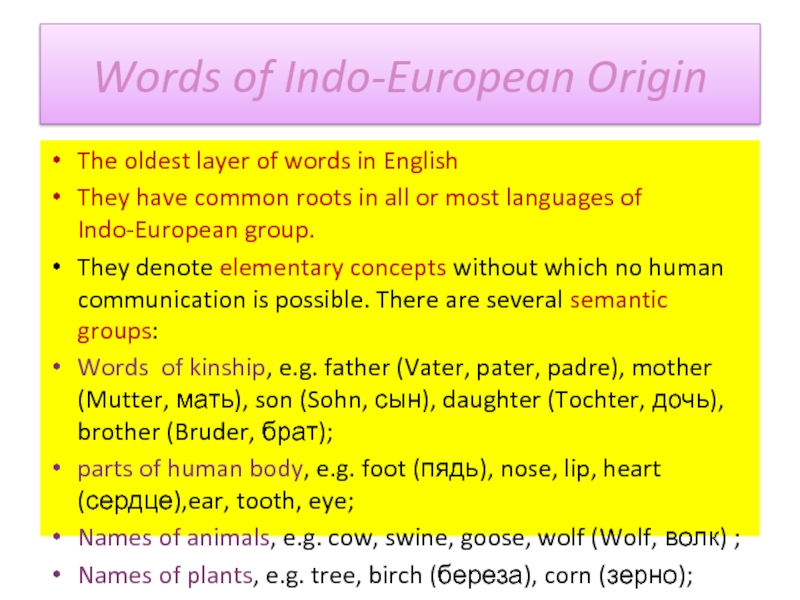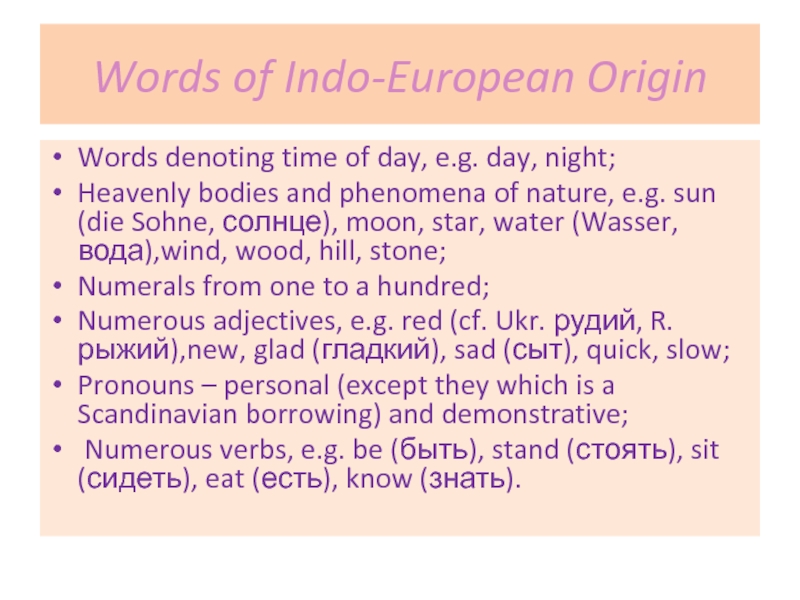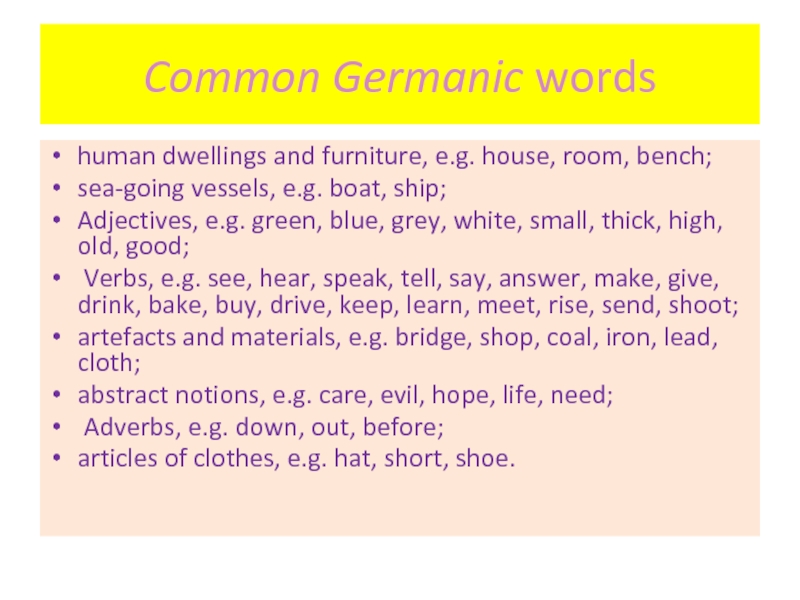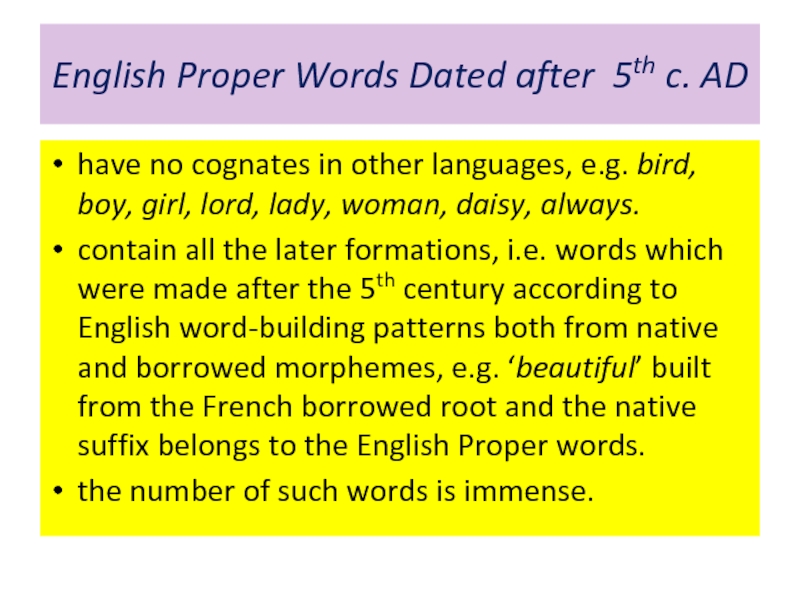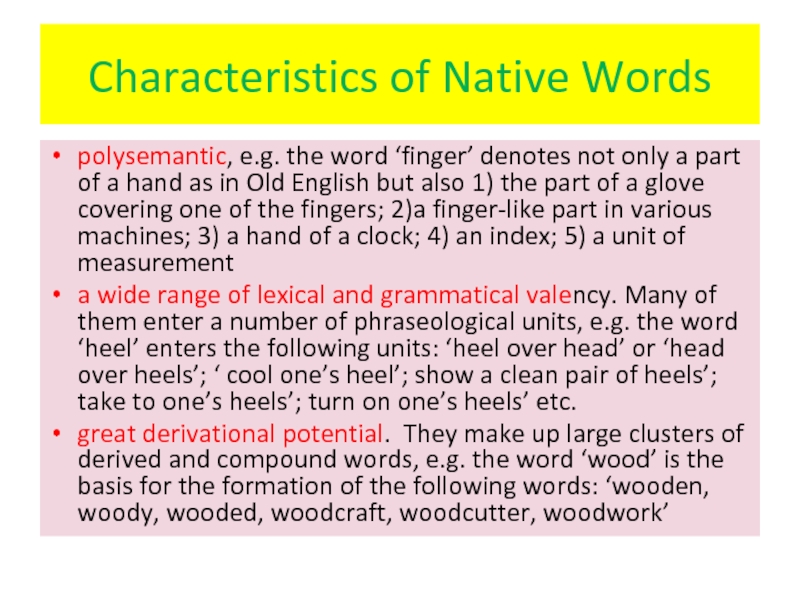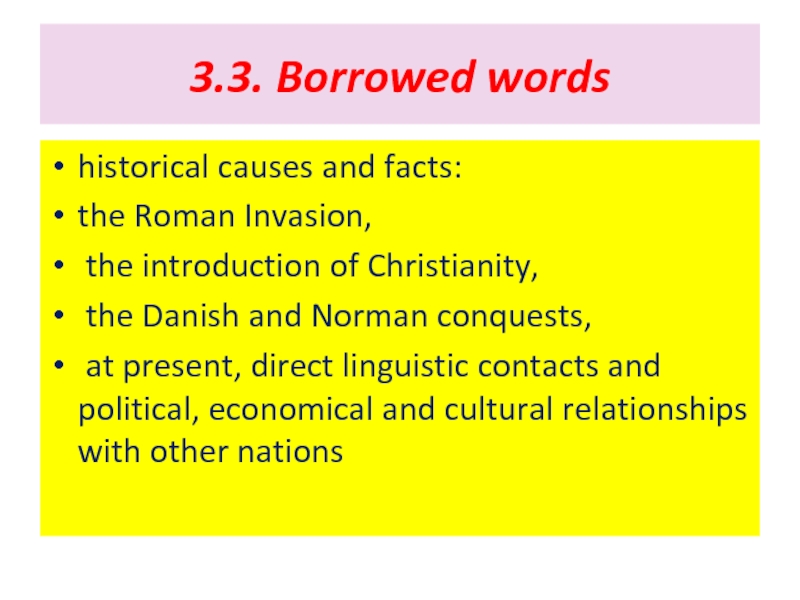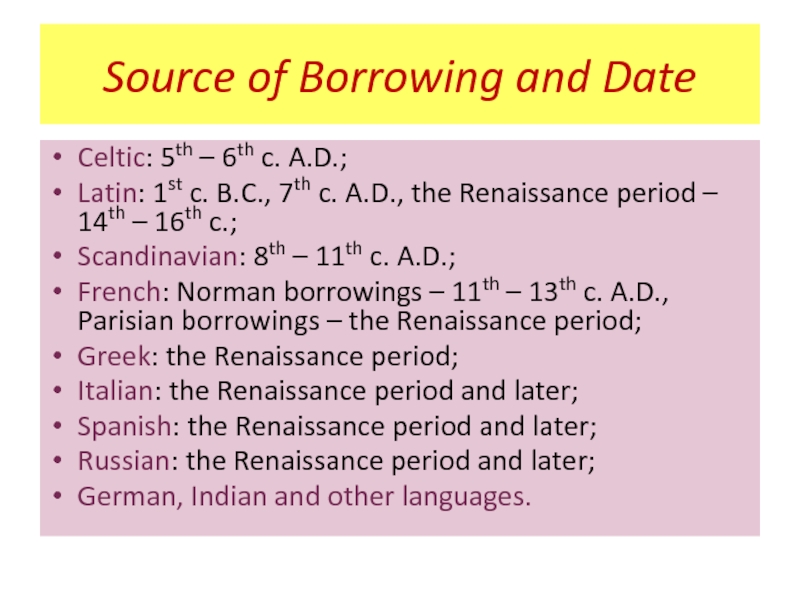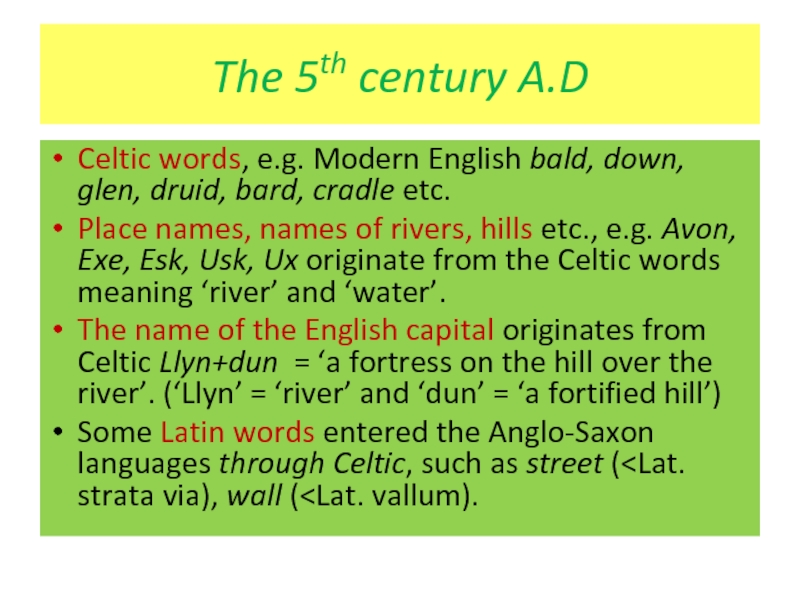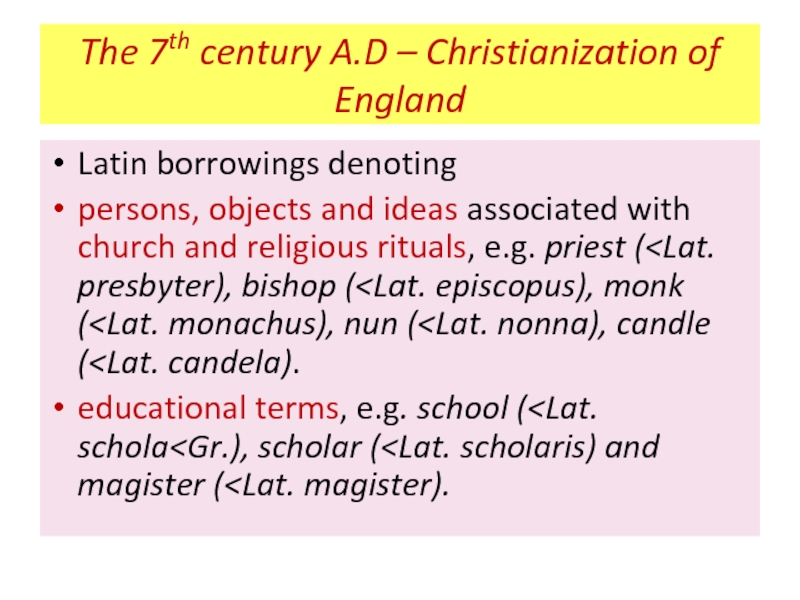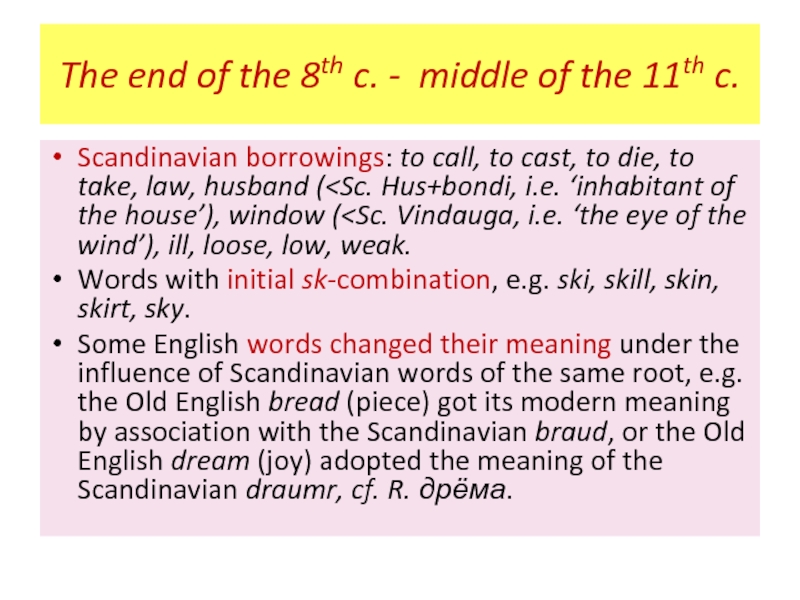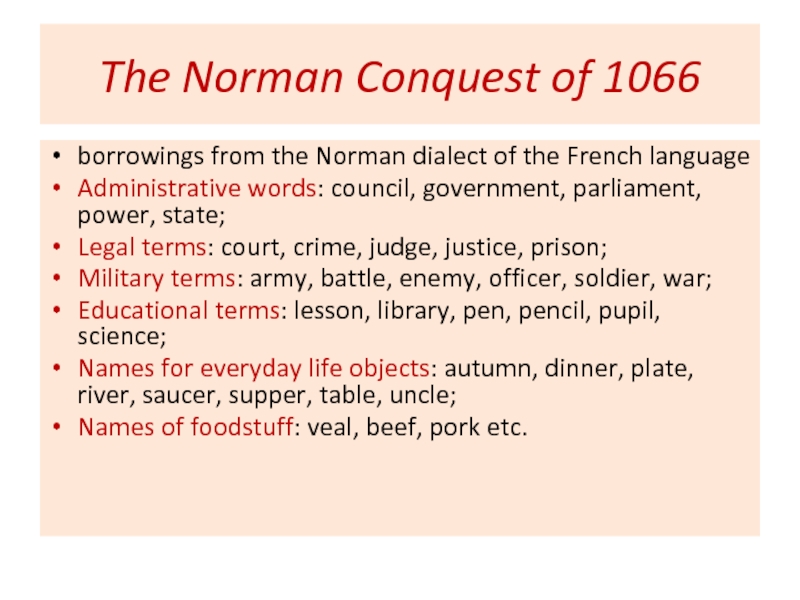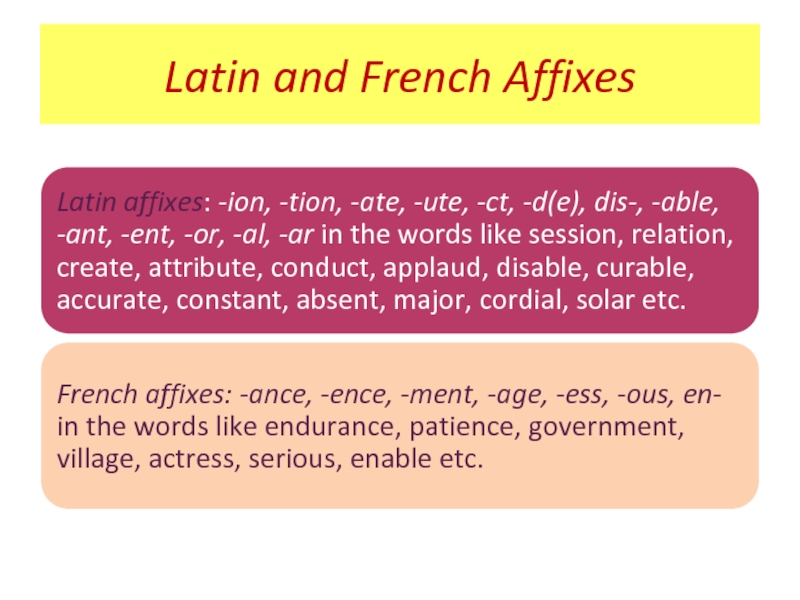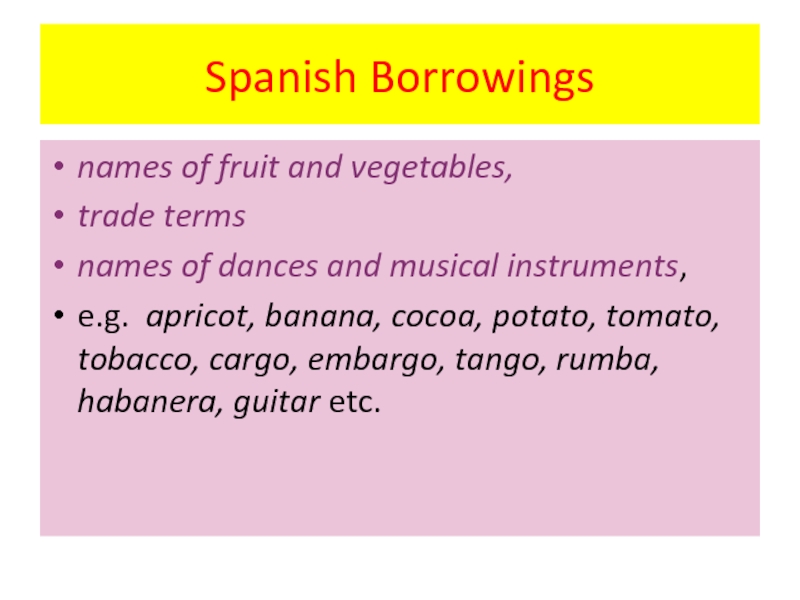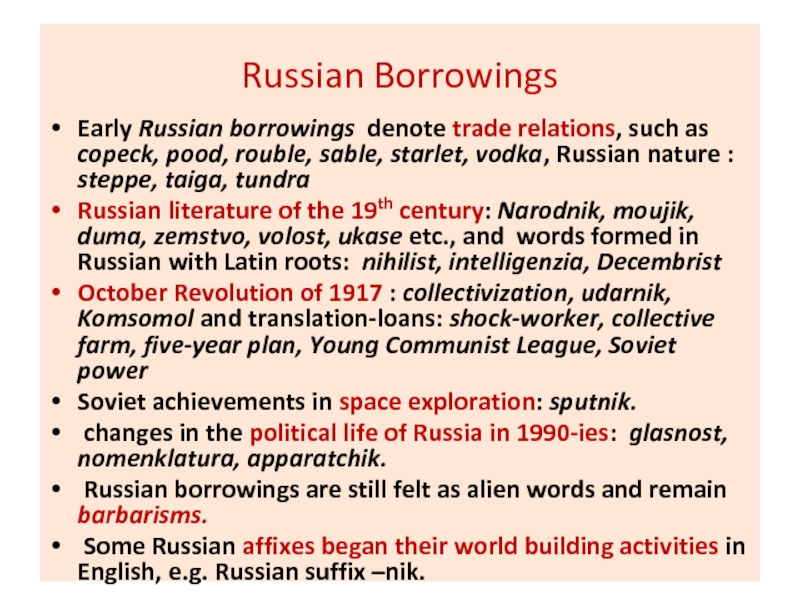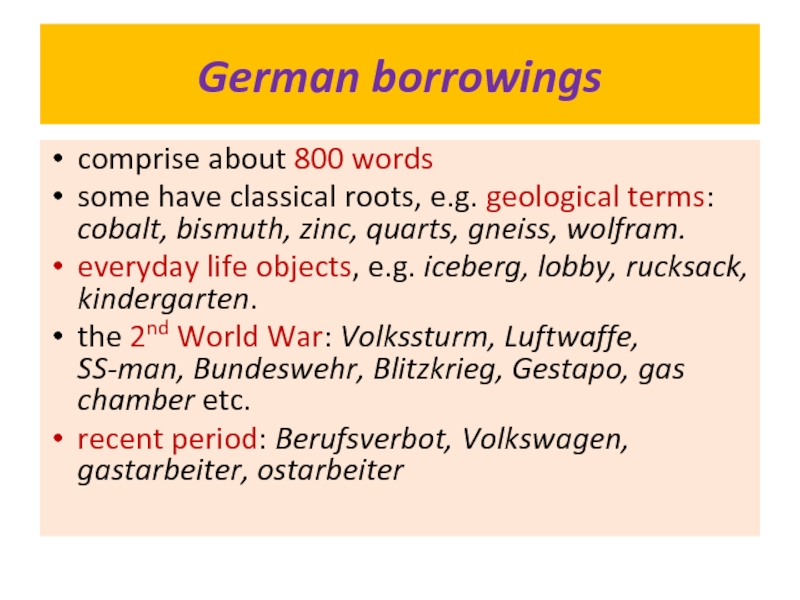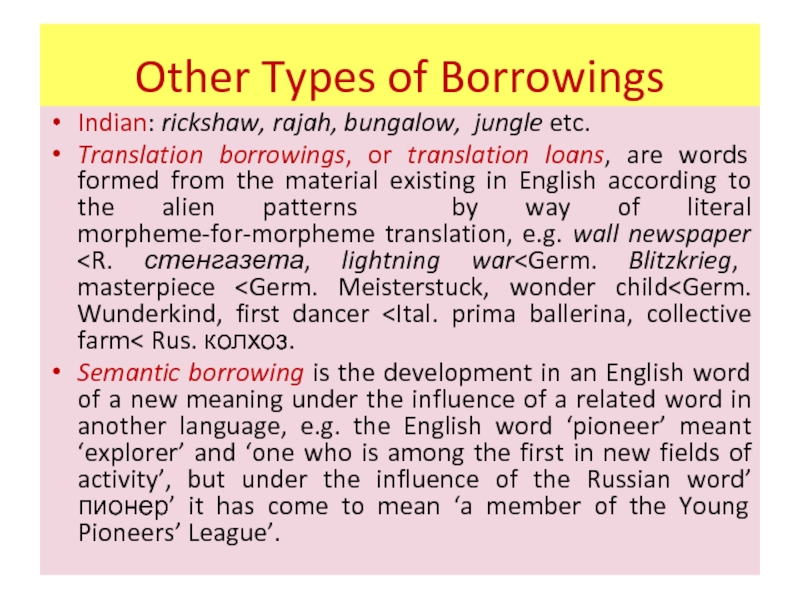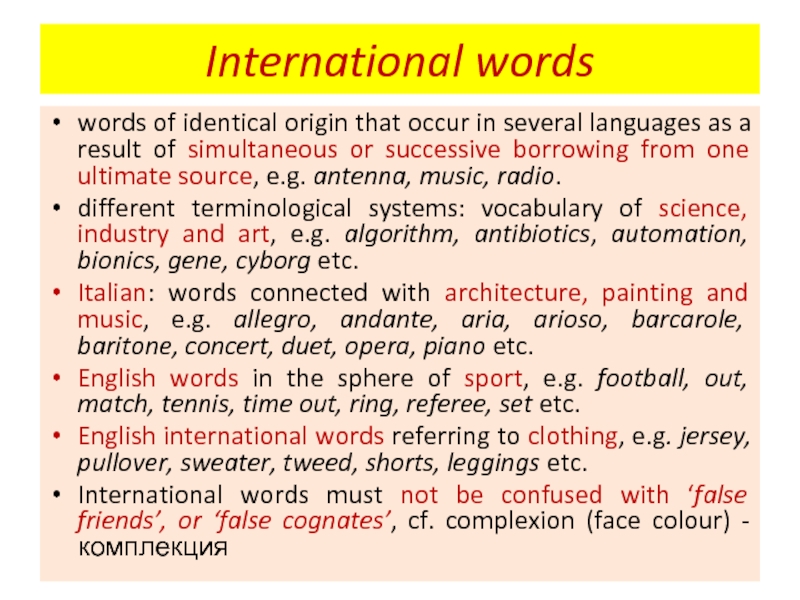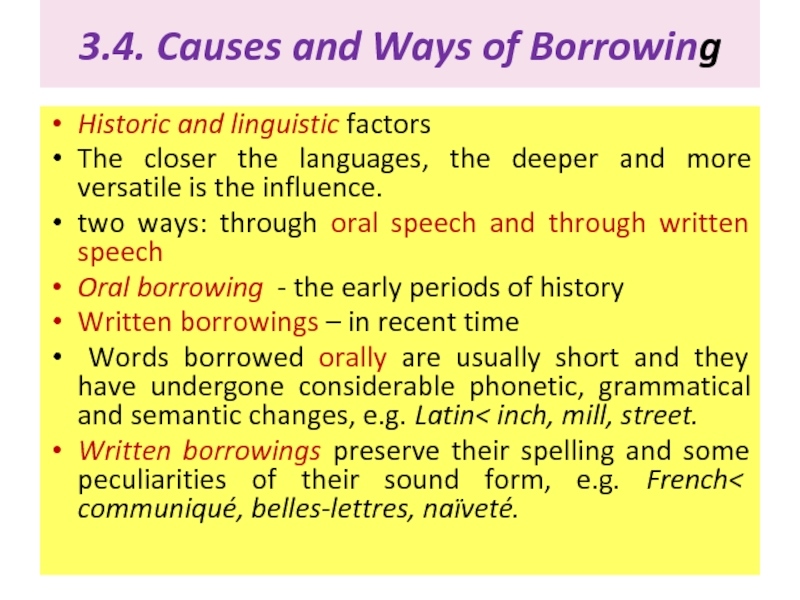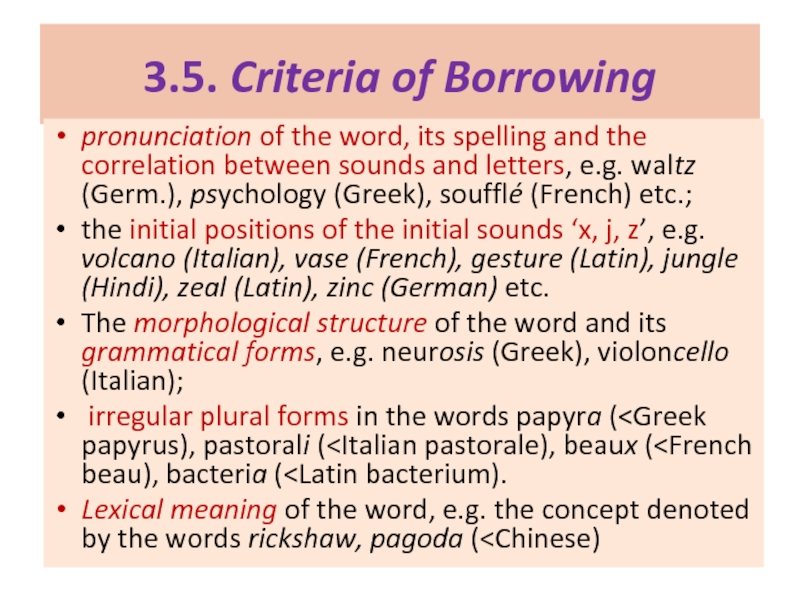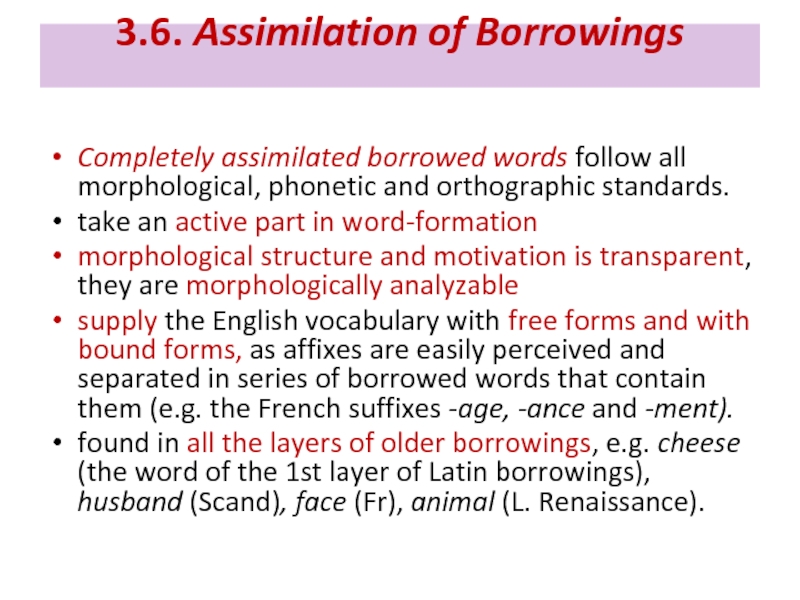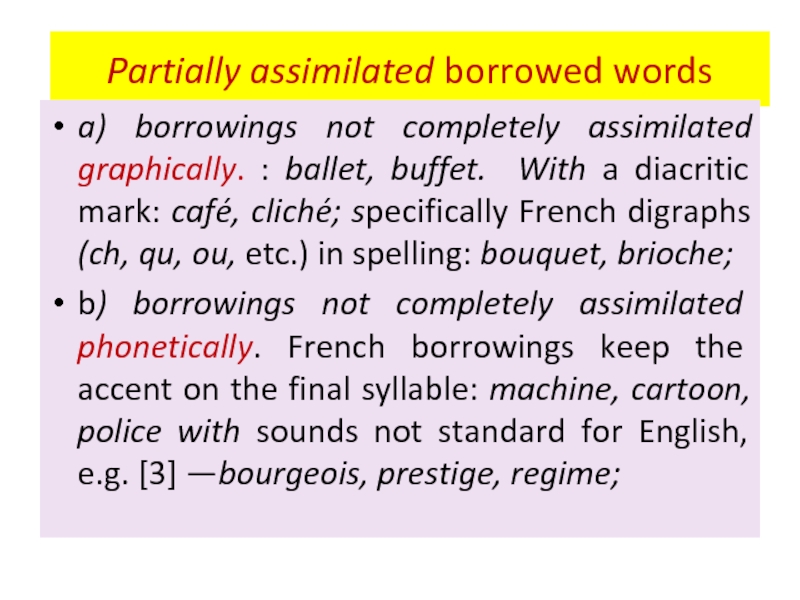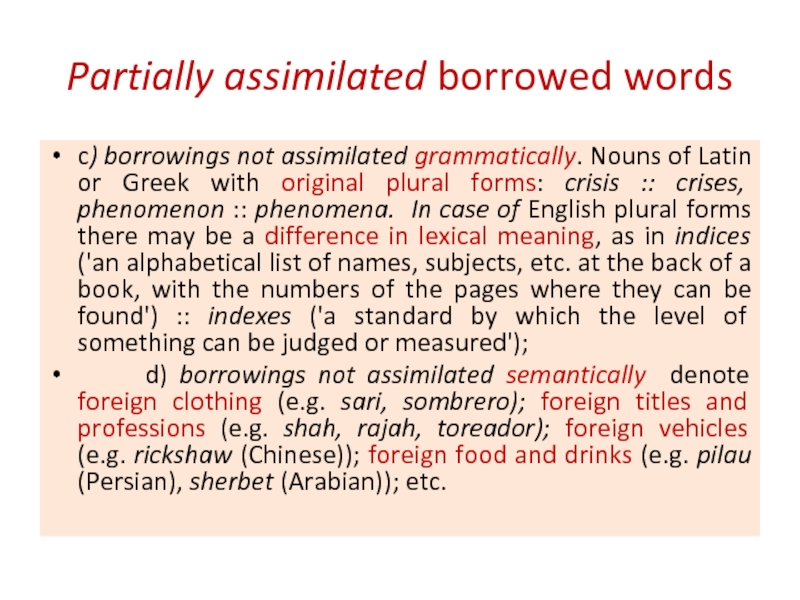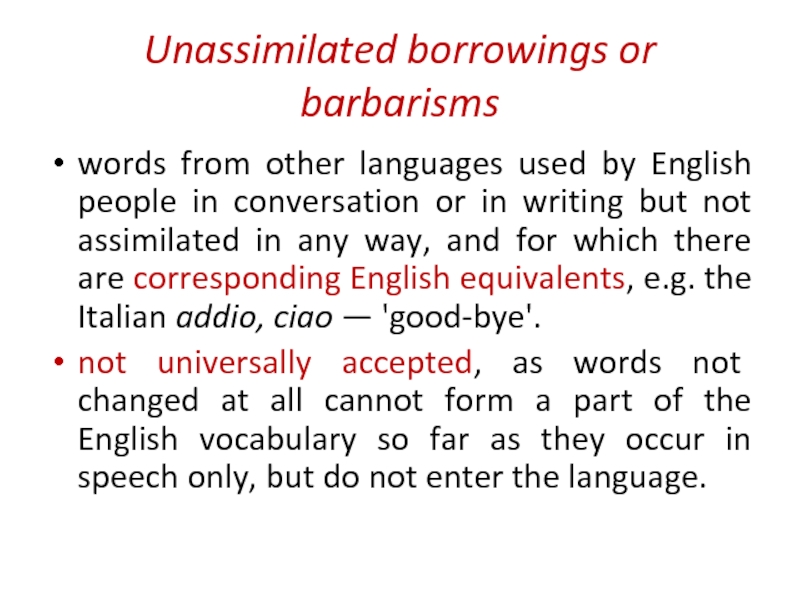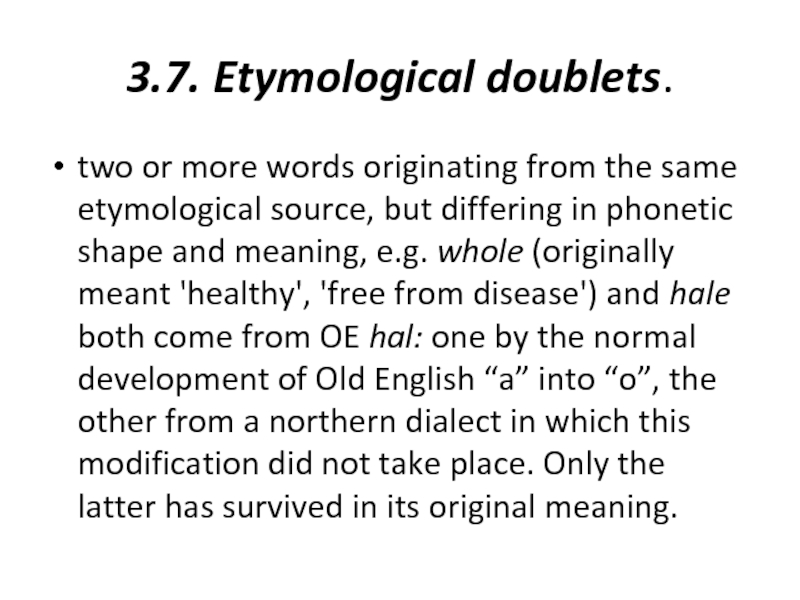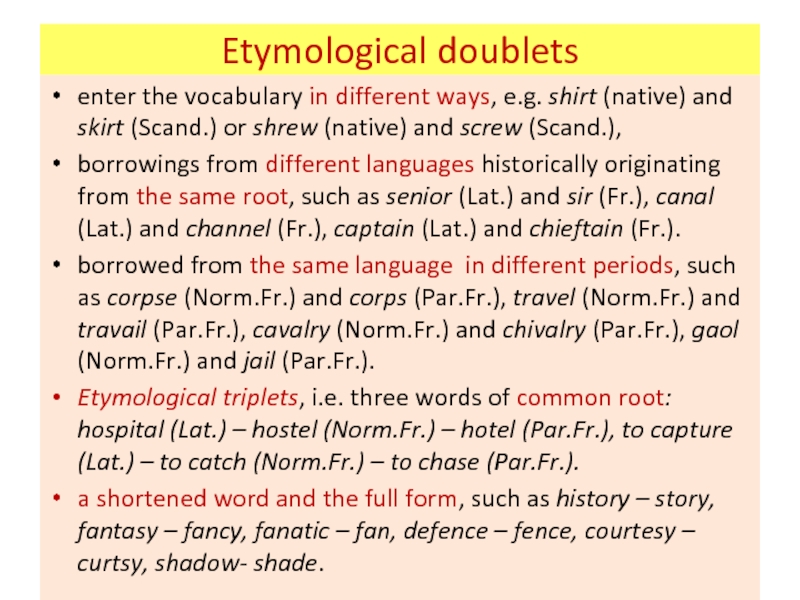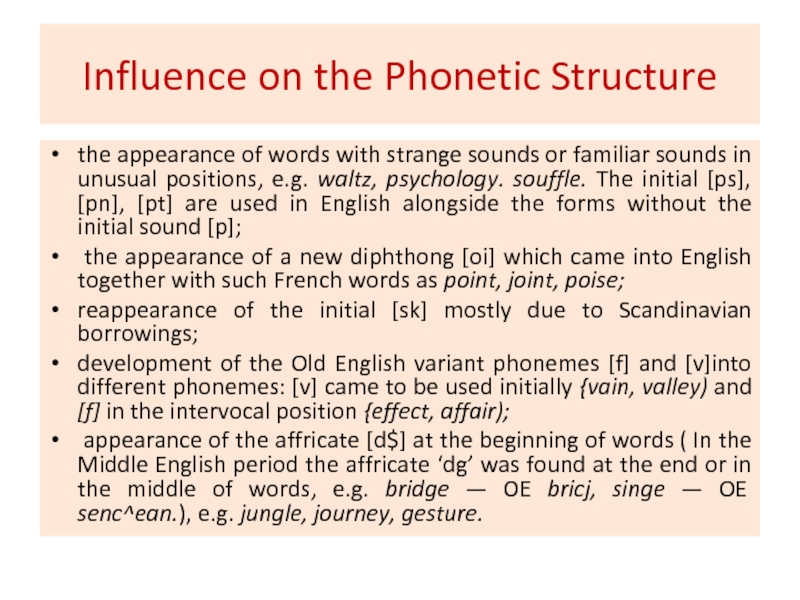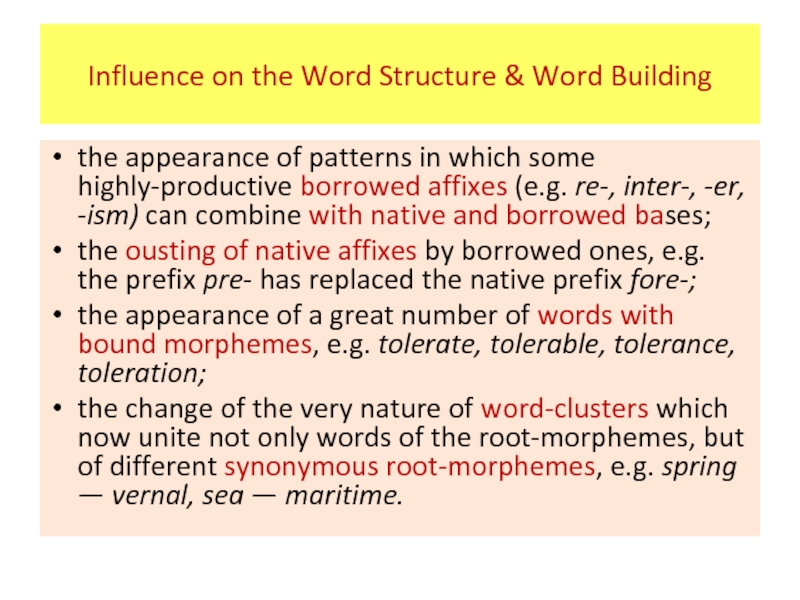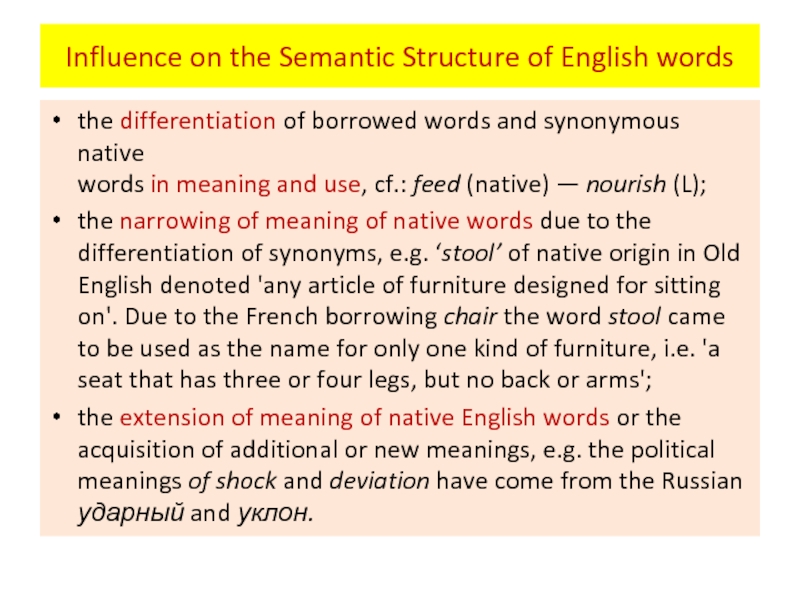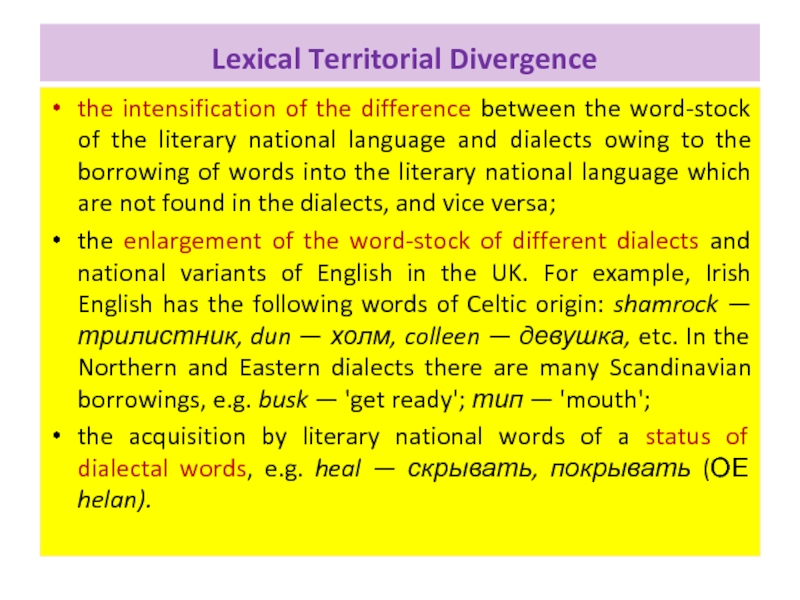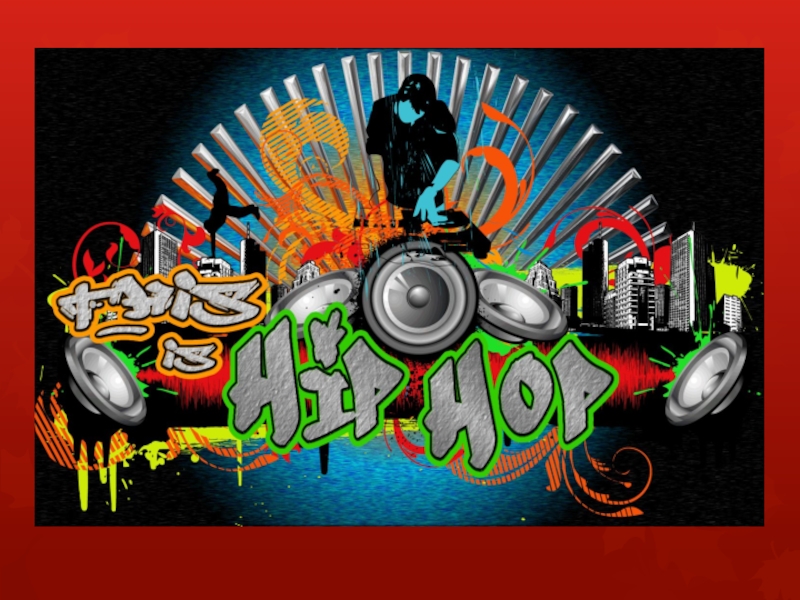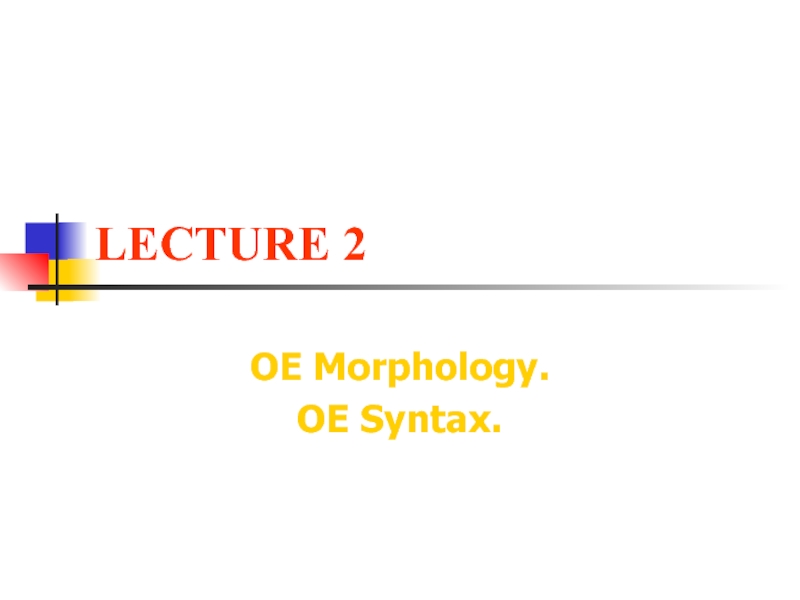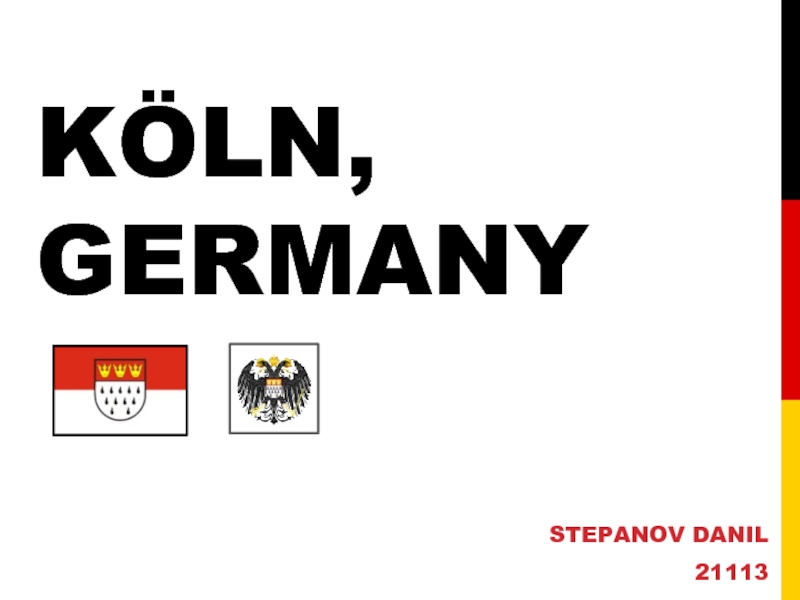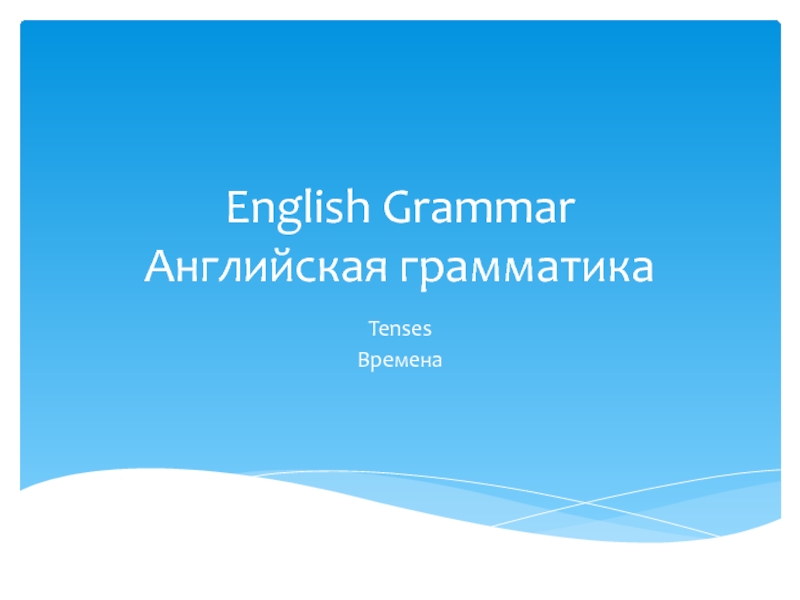- Главная
- Разное
- Дизайн
- Бизнес и предпринимательство
- Аналитика
- Образование
- Развлечения
- Красота и здоровье
- Финансы
- Государство
- Путешествия
- Спорт
- Недвижимость
- Армия
- Графика
- Культурология
- Еда и кулинария
- Лингвистика
- Английский язык
- Астрономия
- Алгебра
- Биология
- География
- Детские презентации
- Информатика
- История
- Литература
- Маркетинг
- Математика
- Медицина
- Менеджмент
- Музыка
- МХК
- Немецкий язык
- ОБЖ
- Обществознание
- Окружающий мир
- Педагогика
- Русский язык
- Технология
- Физика
- Философия
- Химия
- Шаблоны, картинки для презентаций
- Экология
- Экономика
- Юриспруденция
Etymological Characteristics of the English Vocabulary презентация
Содержание
- 1. Etymological Characteristics of the English Vocabulary
- 2. 3.1. The origin of English words
- 3. Source of Borrowing and Origin of Word
- 4. 3.2. Words of native origin Native words
- 5. Words of Indo-European Origin The oldest layer
- 6. Words of Indo-European Origin Words denoting time
- 7. Common Germanic words German, Norwegian, Dutch, Icelandic.
- 8. Common Germanic words human dwellings and furniture,
- 9. English Proper Words Dated after 5th c.
- 10. Characteristics of Native Words polysemantic, e.g. the
- 11. All Native Words are marked by
- 12. 3.3. Borrowed words historical causes and facts:
- 13. Source of Borrowing and Date Celtic: 5th
- 14. The 1st century B.C. Semantically this group
- 15. The 5th century A.D Celtic words, e.g.
- 16. The 7th century A.D – Christianization of
- 17. The end of the 8th c. -
- 18. The Norman Conquest of 1066 borrowings from
- 19. The Renaissance period Greek and Latin borrowings
- 20. Latin and French Affixes
- 21. Spanish Borrowings names of fruit and vegetables,
- 22. Russian Borrowings Early Russian borrowings denote trade
- 23. German borrowings comprise about 800 words some
- 24. Other Types of Borrowings Indian: rickshaw, rajah,
- 25. International words words of identical origin that
- 26. 3.4. Causes and Ways of Borrowing Historic
- 27. 3.5. Criteria of Borrowing pronunciation of the
- 28. 3.6. Assimilation of Borrowings Completely assimilated
- 29. Partially assimilated borrowed words a) borrowings not
- 30. Partially assimilated borrowed words c) borrowings not
- 31. Unassimilated borrowings or barbarisms words from other
- 32. 3.7. Etymological doublets. two or more
- 33. Etymological doublets enter the vocabulary in different
- 34. 3.8. Influence of borrowings 1) the phonetic
- 35. Influence on the Phonetic Structure the appearance
- 36. Influence on the Word Structure & Word
- 37. Influence on the Semantic Structure of English
- 38. Lexical Territorial Divergence the intensification of
Слайд 1Lecture 3. Etymological Characteristics of the English Vocabulary.
1. The Origin of
2. Words of Native Origin.
3. Borrowed Words.
4. Causes and Ways of Borrowing.
5. Criteria of Borrowing
6. Assimilation of Borrowings.
7. Etymological Doublets.
8. Influence of Borrowings.
Слайд 43.2. Words of native origin
Native words constitute up to 30 %
They are the most frequently used words as they constitute 80 % of the 500 most frequent words compiled by Thorndyke and Longe (The Teachers’ Wordbook of 30,000 words. New York, 1959).
Слайд 5Words of Indo-European Origin
The oldest layer of words in English
They
They denote elementary concepts without which no human communication is possible. There are several semantic groups:
Words of kinship, e.g. father (Vater, pater, padre), mother (Mutter, мать), son (Sohn, сын), daughter (Tochter, дочь), brother (Bruder, брат);
parts of human body, e.g. foot (пядь), nose, lip, heart (сердце),ear, tooth, eye;
Names of animals, e.g. cow, swine, goose, wolf (Wolf, волк) ;
Names of plants, e.g. tree, birch (береза), corn (зерно);
Слайд 6Words of Indo-European Origin
Words denoting time of day, e.g. day, night;
Heavenly
Numerals from one to a hundred;
Numerous adjectives, e.g. red (cf. Ukr. рудий, R. рыжий),new, glad (гладкий), sad (сыт), quick, slow;
Pronouns – personal (except they which is a Scandinavian borrowing) and demonstrative;
Numerous verbs, e.g. be (быть), stand (стоять), sit (сидеть), eat (есть), know (знать).
Слайд 7Common Germanic words
German, Norwegian, Dutch, Icelandic.
They represent words of roots
The main semantic groups are:
parts of human body, e.g. head, hand, arm, finger, bone;
plants, e.g. oak, fir, grass;
animals, e.g. bear, fox, calf;
natural phenomena, e.g. rain, frost, storm, flood, ice;
periods of time and seasons of the year, e.g. time, week, winter, spring, summer;
landscape features, e.g. sea, land, ground, earth;
Слайд 8Common Germanic words
human dwellings and furniture, e.g. house, room, bench;
sea-going vessels,
Adjectives, e.g. green, blue, grey, white, small, thick, high, old, good;
Verbs, e.g. see, hear, speak, tell, say, answer, make, give, drink, bake, buy, drive, keep, learn, meet, rise, send, shoot;
artefacts and materials, e.g. bridge, shop, coal, iron, lead, cloth;
abstract notions, e.g. care, evil, hope, life, need;
Adverbs, e.g. down, out, before;
articles of clothes, e.g. hat, short, shoe.
Слайд 9English Proper Words Dated after 5th c. AD
have no cognates in
contain all the later formations, i.e. words which were made after the 5th century according to English word-building patterns both from native and borrowed morphemes, e.g. ‘beautiful’ built from the French borrowed root and the native suffix belongs to the English Proper words.
the number of such words is immense.
Слайд 10Characteristics of Native Words
polysemantic, e.g. the word ‘finger’ denotes not only
a wide range of lexical and grammatical valency. Many of them enter a number of phraseological units, e.g. the word ‘heel’ enters the following units: ‘heel over head’ or ‘head over heels’; ‘ cool one’s heel’; show a clean pair of heels’; take to one’s heels’; turn on one’s heels’ etc.
great derivational potential. They make up large clusters of derived and compound words, e.g. the word ‘wood’ is the basis for the formation of the following words: ‘wooden, woody, wooded, woodcraft, woodcutter, woodwork’
Слайд 11All Native Words
are marked by
stability,
specific semantic characteristics,
wide collocability,
great derivational potential,
wide spheres of application and
high frequency value.
Слайд 123.3. Borrowed words
historical causes and facts:
the Roman Invasion,
the introduction of
the Danish and Norman conquests,
at present, direct linguistic contacts and political, economical and cultural relationships with other nations
Слайд 13Source of Borrowing and Date
Celtic: 5th – 6th c. A.D.;
Latin: 1st
Scandinavian: 8th – 11th c. A.D.;
French: Norman borrowings – 11th – 13th c. A.D., Parisian borrowings – the Renaissance period;
Greek: the Renaissance period;
Italian: the Renaissance period and later;
Spanish: the Renaissance period and later;
Russian: the Renaissance period and later;
German, Indian and other languages.
Слайд 14The 1st century B.C.
Semantically this group comprises mostly names of foodstuff
Слайд 15The 5th century A.D
Celtic words, e.g. Modern English bald, down, glen,
Place names, names of rivers, hills etc., e.g. Avon, Exe, Esk, Usk, Ux originate from the Celtic words meaning ‘river’ and ‘water’.
The name of the English capital originates from Celtic Llyn+dun = ‘a fortress on the hill over the river’. (‘Llyn’ = ‘river’ and ‘dun’ = ‘a fortified hill’)
Some Latin words entered the Anglo-Saxon languages through Celtic, such as street (
Слайд 16The 7th century A.D – Christianization of England
Latin borrowings denoting
persons, objects
Слайд 17The end of the 8th c. - middle of the 11th
Scandinavian borrowings: to call, to cast, to die, to take, law, husband (
Some English words changed their meaning under the influence of Scandinavian words of the same root, e.g. the Old English bread (piece) got its modern meaning by association with the Scandinavian braud, or the Old English dream (joy) adopted the meaning of the Scandinavian draumr, cf. R. дрёма.
Слайд 18The Norman Conquest of 1066
borrowings from the Norman dialect of the
Administrative words: council, government, parliament, power, state;
Legal terms: court, crime, judge, justice, prison;
Military terms: army, battle, enemy, officer, soldier, war;
Educational terms: lesson, library, pen, pencil, pupil, science;
Names for everyday life objects: autumn, dinner, plate, river, saucer, supper, table, uncle;
Names of foodstuff: veal, beef, pork etc.
Слайд 19The Renaissance period
Greek and Latin borrowings - mostly abstract words and
Italian also gave a large number of words to the English language, e.g. alarm, bankrupt, bulletin, colonel, dilettante, fascist, fiasco, gazette, graffiti, manifesto, piano, opera, violin etc.
Слайд 21Spanish Borrowings
names of fruit and vegetables,
trade terms
names of dances
e.g. apricot, banana, cocoa, potato, tomato, tobacco, cargo, embargo, tango, rumba, habanera, guitar etc.
Слайд 22Russian Borrowings
Early Russian borrowings denote trade relations, such as copeck, pood,
Russian literature of the 19th century: Narodnik, moujik, duma, zemstvo, volost, ukase etc., and words formed in Russian with Latin roots: nihilist, intelligenzia, Decembrist
October Revolution of 1917 : collectivization, udarnik, Komsomol and translation-loans: shock-worker, collective farm, five-year plan, Young Communist League, Soviet power
Soviet achievements in space exploration: sputnik.
changes in the political life of Russia in 1990-ies: glasnost, nomenklatura, apparatchik.
Russian borrowings are still felt as alien words and remain barbarisms.
Some Russian affixes began their world building activities in English, e.g. Russian suffix –nik.
Слайд 23German borrowings
comprise about 800 words
some have classical roots, e.g. geological terms:
everyday life objects, e.g. iceberg, lobby, rucksack, kindergarten.
the 2nd World War: Volkssturm, Luftwaffe, SS-man, Bundeswehr, Blitzkrieg, Gestapo, gas chamber etc.
recent period: Berufsverbot, Volkswagen, gastarbeiter, ostarbeiter
Слайд 24Other Types of Borrowings
Indian: rickshaw, rajah, bungalow, jungle etc.
Translation borrowings, or
Слайд 25International words
words of identical origin that occur in several languages as
different terminological systems: vocabulary of science, industry and art, e.g. algorithm, antibiotics, automation, bionics, gene, cyborg etc.
Italian: words connected with architecture, painting and music, e.g. allegro, andante, aria, arioso, barcarole, baritone, concert, duet, opera, piano etc.
English words in the sphere of sport, e.g. football, out, match, tennis, time out, ring, referee, set etc.
English international words referring to clothing, e.g. jersey, pullover, sweater, tweed, shorts, leggings etc.
International words must not be confused with ‘false friends’, or ‘false cognates’, cf. complexion (face colour) - комплекция
Слайд 263.4. Causes and Ways of Borrowing
Historic and linguistic factors
The closer the
two ways: through oral speech and through written speech
Oral borrowing - the early periods of history
Written borrowings – in recent time
Words borrowed orally are usually short and they have undergone considerable phonetic, grammatical and semantic changes, e.g. Latin< inch, mill, street.
Written borrowings preserve their spelling and some peculiarities of their sound form, e.g. French< communiqué, belles-lettres, naïveté.
Слайд 273.5. Criteria of Borrowing
pronunciation of the word, its spelling and the
the initial positions of the initial sounds ‘x, j, z’, e.g. volcano (Italian), vase (French), gesture (Latin), jungle (Hindi), zeal (Latin), zinc (German) etc.
The morphological structure of the word and its grammatical forms, e.g. neurosis (Greek), violoncello (Italian);
irregular plural forms in the words papyra (
Слайд 283.6. Assimilation of Borrowings
Completely assimilated borrowed words follow all morphological, phonetic
take an active part in word-formation
morphological structure and motivation is transparent, they are morphologically analyzable
supply the English vocabulary with free forms and with bound forms, as affixes are easily perceived and separated in series of borrowed words that contain them (e.g. the French suffixes -age, -ance and -ment).
found in all the layers of older borrowings, e.g. cheese (the word of the 1st layer of Latin borrowings), husband (Scand), face (Fr), animal (L. Renaissance).
Слайд 29Partially assimilated borrowed words
a) borrowings not completely assimilated graphically. : ballet,
b) borrowings not completely assimilated phonetically. French borrowings keep the accent on the final syllable: machine, cartoon, police with sounds not standard for English, e.g. [3] —bourgeois, prestige, regime;
Слайд 30Partially assimilated borrowed words
c) borrowings not assimilated grammatically. Nouns of Latin
d) borrowings not assimilated semantically denote foreign clothing (e.g. sari, sombrero); foreign titles and professions (e.g. shah, rajah, toreador); foreign vehicles (e.g. rickshaw (Chinese)); foreign food and drinks (e.g. pilau (Persian), sherbet (Arabian)); etc.
Слайд 31Unassimilated borrowings or barbarisms
words from other languages used by English people
not universally accepted, as words not changed at all cannot form a part of the English vocabulary so far as they occur in speech only, but do not enter the language.
Слайд 323.7. Etymological doublets.
two or more words originating from the same
Слайд 33Etymological doublets
enter the vocabulary in different ways, e.g. shirt (native) and
borrowings from different languages historically originating from the same root, such as senior (Lat.) and sir (Fr.), canal (Lat.) and channel (Fr.), captain (Lat.) and chieftain (Fr.).
borrowed from the same language in different periods, such as corpse (Norm.Fr.) and corps (Par.Fr.), travel (Norm.Fr.) and travail (Par.Fr.), cavalry (Norm.Fr.) and chivalry (Par.Fr.), gaol (Norm.Fr.) and jail (Par.Fr.).
Etymological triplets, i.e. three words of common root: hospital (Lat.) – hostel (Norm.Fr.) – hotel (Par.Fr.), to capture (Lat.) – to catch (Norm.Fr.) – to chase (Par.Fr.).
a shortened word and the full form, such as history – story, fantasy – fancy, fanatic – fan, defence – fence, courtesy – curtsy, shadow- shade.
Слайд 343.8. Influence of borrowings
1) the phonetic structure of English words and
2) the word-structure and the system of word-building;
3) the semantic structure of English words;
4) the lexical territorial divergence.
Слайд 35Influence on the Phonetic Structure
the appearance of words with strange sounds
the appearance of a new diphthong [oi] which came into English together with such French words as point, joint, poise;
reappearance of the initial [sk] mostly due to Scandinavian borrowings;
development of the Old English variant phonemes [f] and [v]into different phonemes: [v] came to be used initially {vain, valley) and [f] in the intervocal position {effect, affair);
appearance of the affricate [d$] at the beginning of words ( In the Middle English period the affricate ‘dg’ was found at the end or in the middle of words, e.g. bridge — OE bricj, singe — OE senc^ean.), e.g. jungle, journey, gesture.
Слайд 36Influence on the Word Structure & Word Building
the appearance of patterns
the ousting of native affixes by borrowed ones, e.g. the prefix pre- has replaced the native prefix fore-;
the appearance of a great number of words with bound morphemes, e.g. tolerate, tolerable, tolerance, toleration;
the change of the very nature of word-clusters which now unite not only words of the root-morphemes, but of different synonymous root-morphemes, e.g. spring — vernal, sea — maritime.
Слайд 37Influence on the Semantic Structure of English words
the differentiation of borrowed
the narrowing of meaning of native words due to the differentiation of synonyms, e.g. ‘stool’ of native origin in Old English denoted 'any article of furniture designed for sitting on'. Due to the French borrowing chair the word stool came to be used as the name for only one kind of furniture, i.e. 'a seat that has three or four legs, but no back or arms';
the extension of meaning of native English words or the acquisition of additional or new meanings, e.g. the political meanings of shock and deviation have come from the Russian ударный and уклон.
Слайд 38 Lexical Territorial Divergence
the intensification of the difference between the word-stock
the enlargement of the word-stock of different dialects and national variants of English in the UK. For example, Irish English has the following words of Celtic origin: shamrock — трилистник, dun — холм, colleen — девушка, etc. In the Northern and Eastern dialects there are many Scandinavian borrowings, e.g. busk — 'get ready'; тип — 'mouth';
the acquisition by literary national words of a status of dialectal words, e.g. heal — скрывать, покрывать (ОЕ helan).
